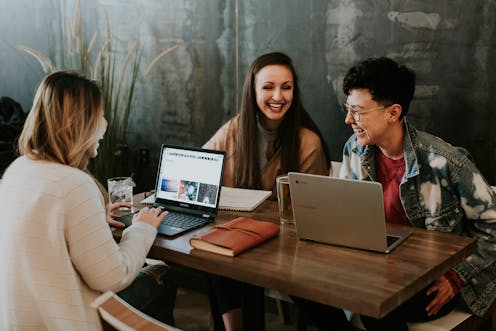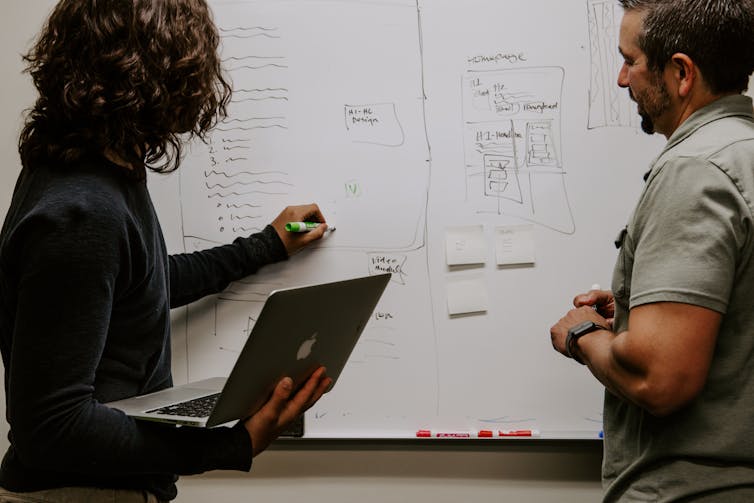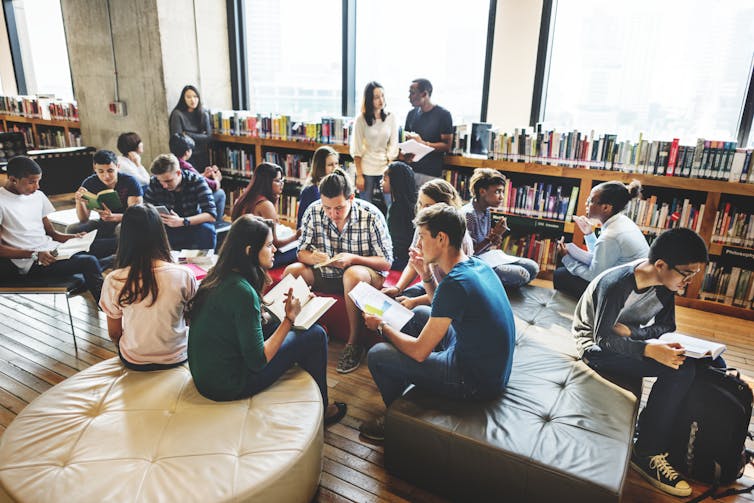Collaborative problem solvers are made not born – here's what you need to know
From the biggest 'wicked' problems on down, finding solutions to challenges depends on working together collaboratively. Students think they're good at this, but they aren't. Here's what could help.

Challenges are a fact of life. Whether it’s a high-tech company figuring out how to shrink its carbon footprint, or a local community trying to identify new revenue sources, people are continually dealing with problems that require input from others. In the modern world, we face problems that are broad in scope and great in scale of impact – think of trying to understand and identify potential solutions related to climate change, cybersecurity or authoritarian leaders.
But people usually aren’t born competent in collaborative problem-solving. In fact, a famous turn of phrase about teams is that a team of experts does not make an expert team. Just as troubling, the evidence suggests that, for the most part, people aren’t being taught this skill either. A 2012 survey by the American Management Association found that higher level managers believed recent college graduates lack collaboration abilities.
Maybe even worse, college grads seem to overestimate their own competence. One 2015 survey found nearly two-thirds of recent graduates believed they can effectively work in a team, but only one-third of managers agreed. The tragic irony is that the less competent you are, the less accurate is your self-assessment of your own competence. It seems that this infamous Dunning-Kruger effect can also occur for teamwork.
Perhaps it’s no surprise that in a 2015 international assessment of hundreds of thousands of students, less than 10% performed at the highest level of collaboration. For example, the vast majority of students could not overcome teamwork obstacles or resolve conflict. They were not able to monitor group dynamics or to engage in the kind of actions needed to make sure the team interacted according to their roles. Given that all these students have had group learning opportunities in and out of school over many years, this points to a global deficit in the acquisition of collaboration skills.
How can this deficiency be addressed? What makes one team effective while another fails? How can educators improve training and testing of collaborative problem-solving? Drawing from disciplines that study cognition, collaboration and learning, my colleagues and I have been studying teamwork processes. Based on this research, we have three key recommendations.

How it should work
At the most general level, collaborative problem-solving requires team members to establish and maintain a shared understanding of the situation they’re facing and any relevant problem elements they’ve identified. At the start, there’s typically an uneven distribution of knowledge on a team. Members must maintain communication to help each other know who knows what, as well as help each other interpret elements of the problem and which expertise should be applied.
Then the team can get to work, laying out subtasks based upon member roles, or creating mechanisms to coordinate member actions. They’ll critique possible solutions to identify the most appropriate path forward.
Finally, at a higher level, collaborative problem-solving requires keeping the team organized – for example, by monitoring interactions and providing feedback to each other. Team members need, at least, basic interpersonal competencies that help them manage relationships within the team (like encouraging participation) and communication (like listening to learn). Even better is the more sophisticated ability to take others’ perspectives, in order to consider alternative views of problem elements.
Whether it is a team of professionals in an organization or a team of scientists solving complex scientific problems, communicating clearly, managing conflict, understanding roles on a team, and knowing who knows what – all are collaboration skills related to effective teamwork.
What’s going wrong in the classroom?
When so many students are continually engaged in group projects, or collaborative learning, why are they not learning about teamwork? There are interrelated factors that may be creating graduates who collaborate poorly but who think they are quite good at teamwork.
I suggest students vastly overestimate their collaboration skills due to the dangerous combination of a lack of systematic instruction coupled with inadequate feedback. On the one hand, students engage in a great deal of group work in high school and college. On the other hand, students rarely receive meaningful instruction, modeling and feedback on collaboration. Decades of research on learning show that explicit instruction and feedback are crucial for mastery.
Although classes that implement collaborative problem-solving do provide some instruction and feedback, it’s not necessarily about their teamwork. Students are learning about concepts in classes; they are acquiring knowledge about a domain. What is missing is something that forces them to explicitly reflect on their ability to work with others.
When students process feedback on how well they learned something, or whether they solved a problem, they mistakenly think this is also indicative of effective teamwork. I hypothesize that students come to conflate learning course content material in any group context with collaboration competency.

A prescription for better collaborators
Now that we’ve defined the problem, what can be done? A century of research on team training, combined with decades of research on group learning in the classroom, points the way forward. My colleagues and I have distilled some core elements from this literature to suggest improvements for collaborative learning.
First, most pressing is to get training on teamwork into the world’s classrooms. At a minimum, this needs to happen during college undergraduate education, but even better would be starting in high school or earlier. Research has demonstrated it’s possible to teach collaboration competencies such as dealing with conflict and communicating to learn. Researchers and educators need, themselves, to collaborate to adapt these methods for the classroom.
Secondly, students need opportunities for practice. Although most already have experience working in groups, this needs to move beyond science and engineering classes. Students need to learn to work across disciplines so after graduation they can work across professions on solving complex societal problems.
Third, any systematic instruction and practice setting needs to include feedback. This is not simply feedback on whether they solved the problem or did well on learning course content. Rather, it needs to be feedback on interpersonal competencies that drive successful collaboration. Instructors should assess students on teamwork processes like relationship management, where they encourage participation from each other, as well as skills in communication where they actively listen to their teammates.
Even better would be feedback telling students how well they were able to take on the perspective of a teammate from another discipline. For example, was the engineering student able to take the view of a student in law and understand the legal ramifications of a new technology’s implementation?
My colleagues and I believe that explicit instruction on how to collaborate, opportunities for practice, and feedback about collaboration processes will better prepare today’s students to work together to solve tomorrow’s problems.
Stephen M. Fiore has received funding from federal agencies such as NASA, ONR, DARPA, and the NSF to study collaborative problem solving and teamwork. He is past president of the Interdisciplinary Network for Group Research, currently a board member of the International Network for the Science of Team Science, and a member of DARPA's Information Science and Technology working group.
Read These Next
Sleep problems and depression can be a vicious cycle, especially during pregnancy − here’s why it’s
Inadequate sleep can have negative downstream effects on everyday cognitive functioning and mental health,…
Whether Netflix or Paramount buys Warner Bros., entertainment oligopolies are back – bigger and mor
Hollywood has seen this movie before.
Can scientists detect life without knowing what it looks like? Research using machine learning offer
A new machine learning model explores the boundary between biological and nonbiological chemistry.






